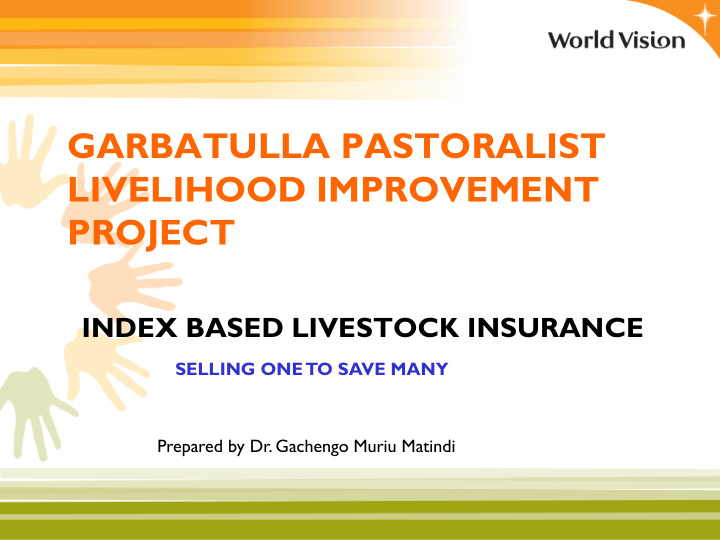



GARBATULLA PASTORALIST LIVELIHOOD IMPROVEMENT PROJECT INDEX BASED LIVESTOCK INSURANCE SELLING ONE TO SAVE MANY Prepared by Dr. Gachengo Muriu Matindi
The GAPLIP Project The Garbatulla Pastoralist Livelihoods Improvement Project seeks to contribute to the overall effort of enhancing pastoral livelihoods and reducing vulnerability. The objective is to use a risk-management solution that is proactive and more focused on the provision of complementary services that could enhance pastoralist livelihood.
GOALS AND OBJECTIVE Project Goal: Reduced vulnerability of pastoral livelihoods in Garbatulla ADP by 2014. Project Outcome # 1: Increased risk management of drought related livestock losses through index based livestock insurance (IBLI) (In partnership with ILRI); Project Outcome # 2: Functional livestock marketing systems developed (In partnership with Farm Concern International (FCI))
Introduction/Background 80% of the population in Garbatulla relies on pastoralism to meet their basic needs (District steering Group report, 2011) The Garbatulla ADP Assessment Report 2010 identified recurring drought as a chronic risk and shock that most threatens the residents’ main source of livelihood which is livestock production; According to lessons learnt by Pastoralist Risk Management (PARIMA) Pastoralists are very vulnerable to widespread forage scarcity and livestock mortality is high due to forage scarcity which is by far the biggest risk.
Progress To date on Outcome 1: IBLI Component/..1 Project was launched officially Garbatulla on 29th July 2013; Road show publicity was done in all the major centers of Garba Tulla district. Sensitization workshop were held for stakeholders and religious leaders Community Baraza’s were held 54 Village Insurance Promoter's (VIPs) were identified
INSURANCE PROVIDERS Contract with APA developed and an operational MOU signed. Contract with TAKAFUL developed later and an MOU signed Web-based platform for information dissemination was developed and applied using Mobile phone
ACRONYMS IBLI: Index Based Livestock Insurance IBLT: Index Based Livestock Takaful
Motivating IBLI: Centrality of Livestock Economy and Risk Profile Source: - ILRI
Motivating IBLI: Centrality of Livestock Economy and Risk Profile Source: - ILRI
• Livestock is the principle asset and key source of income • Pastoralists carry a heavy risk burden of which severe drought is the greatest • Drought-related livestock mortality is the greatest source of vulnerability Source: - ILRI
DROUGHT THE MAJOR PROBLEM OF LIVESTOCK LOSS • Systemic Drought exposure: 28 Droughts Total Value Drought Losses US$ 12.2 billion last 100 years, 4 in last 10 years 0.4% Agriculture • 0.7% Frequency and Intensity increasing 9.1% 3.3% 12.5% Livestock 0.5% • 2008 -2011: 4 consecutive years drought: 0.7% Fisheries 0.4% – Total value damages and losses US$ 12.1 Agro Industry 0.1% billion – Agriculture US$ 1.51 billion (12.5%) Health – Livestock US$ 8.74 billion (72.2%) Nutrition – 9% national livestock herd died – mostly cattle Education 72.2% Energy • Food Insecurity due to drought: – 2009 = 3.8 million people This magnitude of drought damage and – 2011 = 3.75 million people affected, losses to agriculture and livestock • 1.8 million in marginal crop areas cannot be financed out of GOK’s budget • 1.9 million people in marginal pastoral areas and by the Donor community only . Source: - ILRI
Risk Covered and the Index Pastoralist almost entirely depend on livestock as their source of income Drought still a major cause of high livestock mortality in ASALs areas With scarce savings and limited alternative sources of income, pastoralist are therefore exposed to the RISK of drought related livestock mortality Source: - ILRI
Index construction Forage availability is linked to the overall body condition of the livestock Forage level is monitored through satellite pictures through out the year to determine forage level at a given time compared to the “normal” When the forage level is above or equal to the normal, no livestock mortality is predicted Livestock stress and consequent mortality is experience when the forage level goes way below the “normal level”
Index Construction Source: - ILRI
Forage conditions in different seasons in WAJIR Picture2: Good vegetation condition in Picture1: Bad vegetation condition in May 2010, in Wajir Dec 2010, in Wajir Source: - ILRI
Insured livestock unit 1 TLU = 1 Cow, 1 Cow = 1 TLU 1 TLU = 0.7 1 Camel = 1.4 Camel, TLU or 1 TLU = 10 goats 1 goat = 0.1 TLU 1 Sheep= 0.1 1 TLU = 10 sheep. TLU Source: - ILRI
Livestock Sum Assured Average Market Price Livestock TLU Value of TLU (Kshs) (1) (2) (3) (4)= Column (2) × (3) Camel 1.4 Ksh.25,000 35,000 Cattle 1.0 Ksh.25,000 25,000 Goat 0.1 Ksh.25,000 2,500 Sheep 0.1 Ksh.25,000 2,500 Source: - ILRI
Compensation process Clients are informed through sms, agents and chief networks Voucher based MoU signed with APA/TAKAFUL Client presents voucher at the bank and redeems for cash. Identification document is required. Voucher valid for a period of 12 months Source: - ILRI
Selling process Through a network of: Agents Village Takaful Promoters/Village Insurance Promoters Chiefs MoUs with livestock service providers (vets, shops, etc) Promotions through: Local and community radios Mosques Forums Such as Braza’s
Key Challenges encountered this far The community objected to the concept of livestock insurance with the argument that it was against the Islamic faith; The community argued that livestock insurance concept had an element of interest in the sum assured which is against their faith; The community is almost 90% Islamic, and said it was against their faith to undertake any project which would attract interest payment as they considered it “haram” (illegal or unethical ): Only few premiums were bought in the first sale window by the livestock producers in Isiolo South; only one in Boji as most of the community members considered livestock insurance as a coning game by the NGOs and it was like gambling game. The community members were advocating for the redesigning of the project to livestock health or income generating activities targeting the youth and women groups; Source: - ILRI
Recommend
More recommend